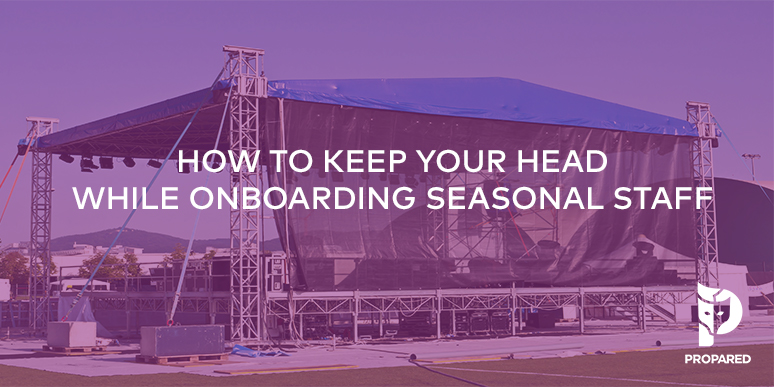
It’s that time of year again! Summer theaters and festivals all over the country are gearing up for their seasons by adding loads of seasonal employees.
Onboarding new staff is not unique. Every company hires new people. What IS unique is the time we have available and the number of people we have to simultaneously onboard. Year-round management teams balloon from just a few people to a full troupe of technicians, managers, designers, and cast almost overnight.
Getting everyone up to speed is challenging. In fact studies say the minimum time to get someone fully onboarded is 90 days. In 90 days your season will be over! As management we have a HUGE (and relatively unique) challenge in front of us over the coming weeks:
1. We have zero time before our employees need to start actually doing critical tasks.
2. Because they’re seasonal, your staff will be coming from all over the place which means there isn’t a common background, history, or set of experiences.
3. You’re simultaneously onboarding them to their jobs as well as the culture of your company. You’ll have to communicate both what their tasks are and how they should present themselves or interact with patrons.
So, how do we do it? What are some ways to accelerate the onboarding process and get people up and running as quickly as possible?
Be Crazy Prepared When They Arrive
Successfully onboarding so many people so quickly requires massive preparation. Here are a few things you should have ready when folks start rolling through the door.
- Goals & Mission of the Organization – Be upfront about the things that matter the most to your company. Don’t just focus on job tasks. Make sure they understand the bigger picture – how they fit in with the overall mission of the company. By doing so, they’ll make better decisions without your constant involvement.
- Job Expectations & Duties – These need to be as clear as possible and include both task responsibilities as well as behavior & culture expectations. Make sure you have formal job descriptions for each role and include their duties to upholding the culture. (you can download a free template here to get you started).
- Who’s Who in the Company – It’s important to know who the other people are working around them. It’s even more important to explain their job roles. This provides context for the world they’re coming in to. Don’t substitute job titles for job descriptions! Your new hires are coming from different places they may have different assumptions about what each job title does.
Give Them a Buddy
Pair up newcomers with a returning hire – someone with whom they can freely ask questions. It shouldn’t be their boss or someone that is involved in the hire/fire process. Make it someone who is relatively familiar with the new person’s job or works in the same department. The goal is to make it okay to ask questions, no matter how trivial they may seem.
It also means that the veteran buddy has some responsibility in the success of the new hire which can help further a positive culture of “we are all in this together!”
Don’t be Afraid of New Blood
We all know that most summer positions are not career positions. For many, it’s an amazing growth opportunity during the early stages of their career. Folks arrive, learn from the experience, make connections, and then move on.
It is important to recognize our role in career growth and celebrate it. It can sometimes be beneficial to not let someone return for another year when it’s clear they’ve outgrown their current position. Just because someone has come back 5 years in a row, doesn’t mean they should still be there.
With a minimum of 90 days required to fully onboard someone into a job, we have to come to grips with the reality that newcomers won’t be fully onboarded in their first season. Period.
So cut yourself some slack! Focus on building your culture, and if you find yourself frustrated and wanting to say, “Get with the program!”, remember that these things take time.
Best of luck with the start of your summer!



